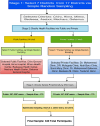Quality of antenatal care and associated factors in public and private facilities of Western Hararghe Zone Ethiopia using WHO framework
- PMID: 40738900
- PMCID: PMC12310994
- DOI: 10.1038/s41598-025-09030-x
Quality of antenatal care and associated factors in public and private facilities of Western Hararghe Zone Ethiopia using WHO framework
Abstract
Achieving equitable health and meeting the sustainable development goals commitment of "leaving no woman behind" requires high-quality antenatal care that ensures a positive pregnancy experience. However, limited studies have assessed the quality of antenatal care using the WHO's quality of care framework, encompassing both experience of care and structural dimensions. This cross-sectional study, conducted from September 1 to October 2, 2020, in the Western Hararghe Zone, Ethiopia, examined the quality of antenatal care among 340 participants selected through multistage stratified sampling. Data were analysed using descriptive statistics and binary logistic regression in SPSS version 27, with significance set at p < 0.05. Results showed that 51.5% [95% CI 46.6-56.8%] of women received quality antenatal care. The domains of effective communication had relatively low quality followed by supportive care then respect, and dignity. The quality of antenatal care was found to be 65.9% and 37.1% in private and public health facilities respectively. Public facilities lacked essential diagnostic equipment, particularly ultrasound. Factors associated with poor antenatal care quality are rural residency, low income, unplanned pregnancies, and public health facilities. Addressing inequities in experience of care coupled with structural attributes is crucial for improving the quality of antenatal care.
Keywords: Antenatal care; Ethiopia; Experience of care; Quality of antenatal care; Quality of care.
© 2025. The Author(s).
Conflict of interest statement
Declarations. Competing interests: The authors declare no competing interests.
Figures
Similar articles
-
Level of satisfaction with the quality of antenatal care services in public health facilities and associated factors among pregnant women in Unguja, Zanzibar.BMC Pregnancy Childbirth. 2025 Aug 14;25(1):847. doi: 10.1186/s12884-025-07816-5. BMC Pregnancy Childbirth. 2025. PMID: 40813657 Free PMC article.
-
Prevalence and associated factors of sexually transmitted infections among pregnant women attending antenatal care in public hospitals in Addis Ababa, Ethiopia.BMC Infect Dis. 2025 Jul 29;25(1):956. doi: 10.1186/s12879-025-11388-2. BMC Infect Dis. 2025. PMID: 40731319 Free PMC article.
-
Time to initiation of antenatal care and its predictors among pregnant women in Ethiopia: Cox-gamma shared frailty model.PLoS One. 2021 Feb 5;16(2):e0246349. doi: 10.1371/journal.pone.0246349. eCollection 2021. PLoS One. 2021. PMID: 33544714 Free PMC article.
-
Health system and community level interventions for improving antenatal care coverage and health outcomes.Cochrane Database Syst Rev. 2015 Dec 1;2015(12):CD010994. doi: 10.1002/14651858.CD010994.pub2. Cochrane Database Syst Rev. 2015. PMID: 26621223 Free PMC article.
-
Antenatal corticosteroids for accelerating fetal lung maturation for women at risk of preterm birth.Cochrane Database Syst Rev. 2017 Mar 21;3(3):CD004454. doi: 10.1002/14651858.CD004454.pub3. Cochrane Database Syst Rev. 2017. Update in: Cochrane Database Syst Rev. 2020 Dec 25;12:CD004454. doi: 10.1002/14651858.CD004454.pub4. PMID: 28321847 Free PMC article. Updated.
References
-
- WHO. WHO Recommendations on Antenatal Care for a Positive Pregnancy Experience (World Health Organization, 2016). - PubMed
-
- Dhakal, P., Gamble, J., Creedy, D. K. & Newnham, E. Quality of measures on respectful and disrespectful maternity care: A systematic review. Nurs. Health Sci.23, 29–39 (2021). - PubMed
MeSH terms
LinkOut - more resources
Full Text Sources
Medical



